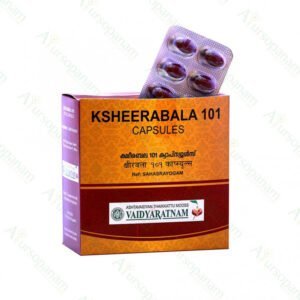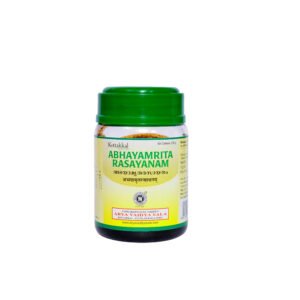Jatyadi oil is a traditional formulation that is used externally in restoring and reinforcing the bodys healing mechanism. Chronic ulcers, piles, fissures, fistula, wounds, bacterial and fungal infections, etc. are some of the areas that Jatyadi oil finds extensive application in.
Healing is inherent to the body. Multiple factors like improper blood circulation, varicosity, immunodeficiency and incompetent tissue repair mechanism can, however, disrupt this natural process. This leads to wounds that refuse to heal and diseases that become chronic.
Features & Benefits
- Coconut oil infused with the Lekhana (cleansing) and Ropana (healing) property of Jatipatra (Myristica fragrans), Kimsuka (Erythrina variegata), Parpatakah (Oldenlandia corymbosa), Mayurika (Achyranthes aspera), Bhadrika (Aerva lanata),Nirgundi (Vitex negundo), Durva (Cyanodon dactylon), Haridra (Curcuma longa), Daruharidra (Coccynium fenestratum), Tuatha (Purified copper sulphate) etc.
- Jatyadi oil is beneficial in wound healing. Keeps away infection. Used for dressing all types of open lesions.
- Used for external application in and around the anus in case of haemorrhoids. Relieves itching, pain and discomfort in the anal region.
- Jatyadi oil also reduces swelling and congestion around the anal opening. Facilitates easy passage of stool.
- Arrests bleeding, relieves pain and promotes healing in case of anal fissures and bleeding piles.
- Used for healing in case of burns, Ksharasootra therapy and various types of lesions.
- Jatyadi oil is also used to cleanse wounds, sloughs off dead tissue, and promotes blood circulation and growth of healthy tissue.
Dosage and Instructions
Quantity sufficient based on the area of application and the condition. in case of open wounds, fissures and cracks, sterile cotton swabs soaked in Jatyadi taila may be used.
Key Ingredients
Narikela Taila (Cocus Nucifera)
Commonly known as coconut oil. topically applied coconut has a moisturizing effect andprevents water loss. It works on all kinds of skins and protects the skin in all seasons. Coconut oil strengthens and enhances hair growth. Coconut oil contains natural saturated fats that increase HDL (good) cholesterol levels in your body.
Jati (Grasminum Grandiflorum)
Its commonly called Royal Jasmine. It has been used for liver disease (hepatitis), liver pain due to cirrhosis, and abdominal pain due to severe diarrhea (dysentery). It is also used to cause relaxation (as a sedative), to heighten sexual desire (as an aphrodisiac), and in cancer treatment. The fresh, tender leaf of the plant is chewed to relieve pain due to dental caries, mouth ulcers and, weak gums. The decoction of the leaf is used for gargling in cases of gingivitis and mouth ulcers.
Parpataka (Fumaria Indica)
Recommended for treatment of fevers and blood disorders. Parpataka is an effective Ayurvedic herb used in fever, high Pitta conditions such as fever, gastritis, diarrhea, excessive thirst, etc. Its famous herbal remedy Shadanga Paneeya (a drink made out of six herbs) is used in treating fever and associated thirst.
Mayurika (Achyranthes Aspera)
Also called Apamarga, it has been extensively used in Ayurveda as an anti-inflammatory agent besides being useful in Hemorrhoids, indigestion, cough, asthma, anemia, jaundice, and snakebite. The kshara or salts of this plant are also used to cure moles, fistula and, bleeding piles. The herb is a good appetizer and can be used instead of our usual antacids. It is a blood purifier and is used for edema and inflammation. The plant also reduces the acidity of urine and is used to tackle renal calculi. Its oil is used locally for earache.
Bhadrika (Aerva Lanata)
Commonly called The Mountain Knotgrass. Aerva lanata is commonly described in Ayurveda as a diuretic with anti-inflammatory, antihelmintic, anti-bacterial, and mild analgesic effects. It is used in the treatment of lithiasis, cough, asthma, and headache and as an antidote for rat poisoning. The dried leaf and flowers are burnt and the smoke coming from it is used for inhalation to treat asthma and chronic cough. The paste of the plant is applied over the forehead to treat a headache. The paste of the root is made into a decoction and given in a dose of 30 ml to treat gonorrhea.
Nirgundi (Vitex Nigundo)
Commonly used drug in Ayurvedic preparations. The Nirgundi Taila is bestowed with potent antibacterial, antiviral and anti-inflammatory properties that make it an effective remedy for ulcers and inflammation. Oil is used to treat an array of respiratory disorders including congestion, cough, bronchitis, and pleura inflammatory conditions. Vitex negundo relieves muscle aches and joint pains. The leaf, seed, and the root are used to treat excessive vaginal discharge, edema, skin diseases, helminthiasis, rheumatism, and puerperal fever.
Yashtimadhu (Glycyrrhiza Glabra)
Roots as choorna are mainly used for Ayurvedic preparations as well as single drugs.Yashtimadhu oil externally used for various skin conditions as well as decoctions is usedinternally for respiratory disorders and digestive disorders. Yashtimadhu can be used effectively in the prevention and treatment of oral mucositis post-radiation and chemotherapy in patients of cancer, especially of the head and neck region. The presence of glycyrrhizin and its compound, carbenoxolone, makes yashti a good remedy for constipation, acidity, heartburn, stomach discomfort, inflammation of the digestive system, and gastro esophageal acid reflux. It also works as a mild laxative and helps bowel movements.
Krishna Jeeraka (Nigella Sativa)
Commonly known as Cumin. Cumin seeds are boiled in water and used as drinking water. Cumin seeds stimulate the digestive enzymes which reduce bloating. It is also used as a liver tonic, digestive, antidiarrhoeal, and to control parasitic infections and boost the immune system. The seeds of Sativa are widely used in the treatment of various diseases like bronchitis, asthma, diarrhea, rheumatism, and skin disorders. It is also used as a liver tonic, digestive, anti-diarrheal, appetite stimulant, to increase milk production in nursing mothers to fight parasitic infections and to support the immune system.
Haridra (Curcuma longa)
Commonly known as Turmeric and easily found in the kitchen. Possesses anti-inflammatory,anti-allergic, anti-oxidant properties. The drug is commonly used in insect bites, indigestion, anorectal conditions like hemorrhoids, etc. Turmeric powder mixed in water and taken in the early morning eliminates the toxins from the body. Haridra paste is applied over the face to remove pigments and improve skin tone and complexion.
















































Ratings & Customer Reviews
Reviews
There are no reviews yet.